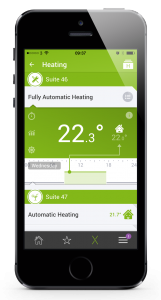
Smart Heating In The Office: A Closer Look At Infrared Panels
If you’ve ever worked in an office you’ll probably have come across that one person who’s permanently cold. They’re always “a bit chilly” in the summer, “freezing” in the winter, and sometimes you swear you’ve seen them tiptoeing over to the thermostat to turn it up by a degree or forty.
When we first moved into our new offices, I’m ashamed to admit to being that person. It was May, but believe me, it was coats and boots all round. Thankfully those days are long gone and our smart heating system ensures my toes remain mostly toasty all year round.
In addition to a fully automated HVAC system distributed throughout the building, we’ve got two wall mounted infrared panels, courtesy of our friends over at Infrared Heating Technologies.

These particular infrared panels are engineered by the German brand REDPUR and as you’d expect, no element of their design has been overlooked.
Usually radiators tend to be a bit of an eyesore in the room, but these panels are modern and minimalistic, and can even have images printed onto them, making them appear more like a canvas than a radiator. The one in the photo opposite is sneakily disguised as a picture above the sofa.
Infrared heating in the home might seem like a new trend, yet it’s the most basic form of heating known to man. Ever enjoyed the warmth of the sun on your face when stepping out into a cold winter’s day? That’s the infrared rays from the sun heating you directly, rather than the air around you. Similarly, instead of heating the air like a traditional radiator (or storage heater), infrared heaters heat solid objects directly which then warm up.
The Advantages of Infrared Heaters
One of the biggest benefits of infrared panels is that they are very quick to heat up, usually taking just minutes to achieve the room’s target temperature.
They’re also much less intrusive to install compared to a ‘wet’ system radiator since there’s no need to run any pipes. The maintenance on them is minimal too, and they have a lifespan of 30-40 years.
In terms of energy efficiency, infrared certainly has its plus points. With conventional central heating, you need the whole gas boiler to fire up even if you want to heat just one room. Heating people directly rather than warming the air around them is a faster and more efficient way to heat a room using less energy.

If you own an older property (or if you’ve ever lived in a damp student house) you may well know the the grim reality of wiping condensation and mould from your window frames. Unlike traditional radiators which work on a convection principle, infrared heaters are often cited as being the best option for preventing mould due to the fact they radiate heat without altering the humidity or circulating allergens.
There’s another advantage to infrared heaters too, and it’s one that most people overlook. They’re completely silent. Imagine it’s early on a cold, dark morning. The birds, much like you, are still tucked up in their nests when suddenly a loud gurgling noise stirs you from your sleep. Glaring  sleepily at the family dog, you roll over and try to return to the land of nod. Only it’s not the dog, it’s your radiators wearily coming to life. So if your home is blessed with creaky radiators or noisy pipes, you’ll appreciate the beauty of silent heating more than anyone.
sleepily at the family dog, you roll over and try to return to the land of nod. Only it’s not the dog, it’s your radiators wearily coming to life. So if your home is blessed with creaky radiators or noisy pipes, you’ll appreciate the beauty of silent heating more than anyone.
Managed by the Miniserver
 In our offices, there is a motion sensor in every room to keep an eye on the room’s occupancy. This is especially handy in the meeting room and upstairs in the office as it ensures that the heating and lights don’t get shut off automatically at the end of the day if a meeting is overrunning or we’re working late.
In our offices, there is a motion sensor in every room to keep an eye on the room’s occupancy. This is especially handy in the meeting room and upstairs in the office as it ensures that the heating and lights don’t get shut off automatically at the end of the day if a meeting is overrunning or we’re working late.
As you may already be aware, the Loxone Smart Home App is great for viewing energy usage stats and the infrared panels are no exception. We’ve connected each of them to a Smart Socket Air (which has an in-built power monitor) so that we can see exactly how much energy each panel uses.
Connecting them into the Loxone system also makes them easily controllable. If we feel like advancing or lowering the temperature, a quick tap on Room Mode on the wall mounted iPad tells the Miniserver exactly what to do.
Where Can I Find Out More?
For more information about smart heating with Loxone, simply request a brochure or visit the website.
To find out more about installing infrared panels in your own home, please click here to visit the Infrared Heating Technologies website.